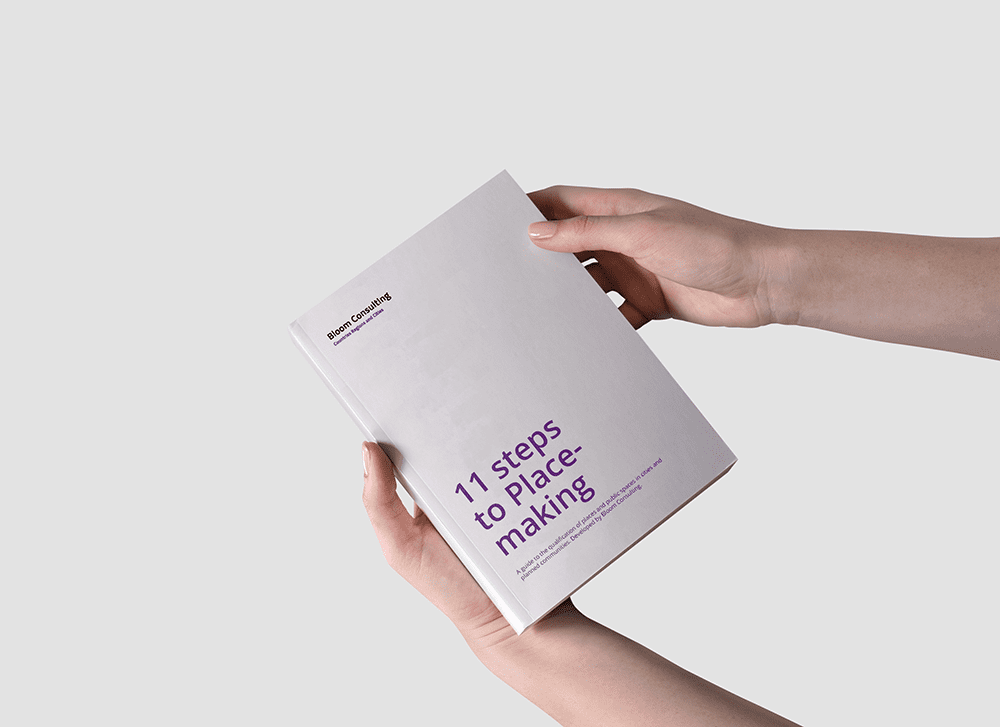In keeping with Bloom Consulting’s tradition of making lives easier when it comes to the universe of places, cities and countries, we’ve launched a new manual on Placemaking. The step-by-step guide explains the process of qualifying places through transformations in public spaces and collectives.
We take a different approach to Placemaking and have named our methodology Placemaking.ID®. The name comes from the junction of traditional Placemaking – commonly referred to as the qualification of public spaces – with the ID or identity, or the raw material of the Place Branding.
We share the idea that the quality of a place is largely measured by the quality of its public spaces. Therefore, Placemaking.ID® works to align Place Brand ideas, no matter their scale or nature, from neighbourhoods to capitals, from public to private, into a set of tangible initiatives in the public and collective spaces, thus creating an aligned and surprising experience for both visitors and the community itself.
More than collaborating, it is necessary to co-create
In this collective process, we create and strengthen community ties, initiating a sense of belonging. This is equally important, no matter the type of project. For example, in the creation of new neighbourhoods for the private sector, it generates a set of symbolic, innate characteristics. The real estate entrepreneur can then align the urban design, communication and marketing around something authentic and inherent to the place, which is not easily copied.
For public authorities, Placemaking.ID® generates political capital in the form of a legacy, thanks to involving people, giving them a voice and acting in the mitigation of community problems.
Sense of belonging, assertiveness and legacy
Placemaking.ID® is much more than an arsenal of research and co-creation tools. By involving the community, we generate ideas that touch on the three dimensions of a place: Hardware, Software and Peopleware. Once the vision of the Place has been aligned based on its identity and positioning (Place Branding layer), we create the necessary elements for developing new infrastructure and recommendations for urban planning (Hardware), a program of activities and attractiveness (Software) and governance with people as the main agent of transformation (Peopleware).
Infrastructure and uses + activities and attractions + culture and governance
It may seem that our process is limited to a snapshot of the current moment, or worse, to an image that is already in the past, like so much other research that provides an overview of the “moment,” that is, of yesterday.
Along with all the collaboration and co-creation, Placemaking.ID® comes with two other essential elements for today’s world: future perspectives and antifragility to create “future proof” places. By looking at the Hardware, Software and Peopleware, we develop dynamic and adaptable systems from the beginning of the project. Systems, which can adapt and evolve in the face of the challenges of an uncertain future.
Placemaking.ID®, therefore, engages the community by creating solid and authentic foundations for public or private projects in addition to a sense of belonging. It creates transformative experiences in public spaces for residents and visitors, materializing the concepts of Place Branding. Finally, it involves designing places that are more prepared to deal with contemporary crises, be they social, economic, political, or environmental.
Why engage in Placemaking.ID®
For the private sector
- To materialize the concept of Place Branding and create unique and vibrant places capable of delivering memorable experiences.
- To create a sense of belonging in a place and thereby reinforce it’s cultural and identifying characteristics.
- To create innovative, unique, and assertive products.
- To optimize resources and maximize profit through cohesive and validated guidance.
- To create authentic and recognizable places, increasing the perception of value for the product and the brand.
For public authorities
- To create unique and vibrant places capable of delivering memorable experiences.
- To create a sense of belonging and community.
- To insert the place in the universe of choice for visitors, residents, investors, and talents.
- To optimize resources through a cohesive and validated approach, minimizing critical actions and at the same time creating cohesive experiences that materialize Place Branding and the positioning of the city.
- To create antifragile places.
Step 1. Develop a deep understanding of the culture of the place
Nobody understands the reality of a place better than its inhabitants!
> Go to step 1
Step 2. Engage the community
The most important thing in this step is to create a participant base. It should represent the different cultures and subcultures observed in step one and confirmed by other data sources, such as social media mapping and academic bases.
> Go the step 2
Step 3. Search for your digital identity
Although the starting point is the community itself, it is equally important to know what the rest of the world thinks of the place – to gain a perspective from beyond the local.
> Go to step 3
Step 4. Create a shared vision
“A vision of the future helps to align expectations, establish strategies, objectives and, just as importantly, success metrics.”
> Go to step 4
Step 5. Co-create occupancy guidelines for public spaces
As you embark on understanding the place (step one), you can also analyze the quality of its public spaces. This serves to understand what the community/customer expects from a new place and what they need there.
> Go to step 5
Step 6. Bring cultural identities into place
Now that you have mapped the existing behaviors in the place and its surroundings, it’s time to reinforce these identities in the territory.
> Go to step 6
Step 7. Create connections between identities
Now we’ll create another layer of meaning that can change your view of identity territories.
> Go to step 7
Step 8. A place is much more than its buildings
The quality of the activity matters more than the quality or even the quantity of public facilities available.
> Go to step 8
Step 9. Be dynamic, adaptable, and agile
No, we cannot predict the future. That is precisely why we must prepare for it by designing more adaptable and dynamic systems.
> Go to step 9
Step 10. A place stretches far beyond its territory
Deterritorialization has become even more evident in light of the Covid-19 pandemic. We must think about experiences beyond the physical and face-to-face.
> Go to step 10
Step 11. Be an antifragile place
Think beyond resilience, in ways to keep places vibrant and sustainable in the face of an uncertain future.
> Go to step 11
Published on 07.04.2022.











